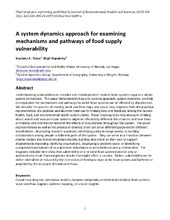| dc.contributor.author | Stave, Krystyna | |
| dc.contributor.author | Kopainsky, Birgit | |
| dc.date.accessioned | 2017-11-07T09:32:40Z | |
| dc.date.available | 2017-11-07T09:32:40Z | |
| dc.date.issued | 2015-09 | |
| dc.Published | Stave K, Kopainsky B. A system dynamics approach for examining mechanisms and pathways of food supply vulnerability. Journal of Environmental Studies and Sciences. 2015;5(3):321-336 | eng |
| dc.identifier.issn | 2190-6483 | |
| dc.identifier.issn | 2190-6491 | |
| dc.identifier.uri | https://hdl.handle.net/1956/16863 | |
| dc.description.abstract | Understanding vulnerabilities in complex and interdependent modern food systems requires a whole-system perspective. This paper demonstrates how one systems approach, system dynamics, can help conceptualize the mechanisms and pathways by which food systems can be affected by disturbances. We describe the process of creating stock-and-flow maps and causal loop diagrams from the graphical representation of a problem and illustrate their use for making links and feedback among the human health, food, and environmental health sectors visible. These mapping tools help structure thinking about where and how particular systems might be affected by different disturbances and how flows of material and information transmit the effects of disturbances throughout the system. The visual representations as well as the process of creating them can serve different purposes for different stakeholders: developing research questions, identifying policy leverage points, or building collaboration among people in different parts of the system. They can serve as a transition between mental models and formal simulation models, but they also stand on their own to support diagrammatic reasoning: clarifying assumptions, structuring a problem space, or identifying unexpected implications of an unplanned disturbance or an intentional policy intervention. The diagrams included here show that vulnerability of a national food system does not only or automatically result from exogenous shocks that might affect a country. Rather, vulnerability can be either intensified or reduced by the interaction of feedback loops in the food system, and buffered or amplified by the structure of stocks and flows. | en_US |
| dc.language.iso | eng | eng |
| dc.publisher | Springer | eng |
| dc.subject | Causal loop diagram | eng |
| dc.subject | Conceptual models | eng |
| dc.subject | Dynamic complexity | eng |
| dc.subject | Modern industrialized food systems | eng |
| dc.subject | Stock-and-flow diagram | eng |
| dc.subject | Systems mapping | eng |
| dc.subject | Structural insights | eng |
| dc.title | A system dynamics approach for examining mechanisms and pathways of food supply vulnerability | eng |
| dc.type | Peer reviewed | en_US |
| dc.type | Journal article | en_US |
| dc.date.updated | 2017-09-28T20:46:59Z | |
| dc.description.version | acceptedVersion | |
| dc.rights.holder | Copyright AESS 2015 | en_US |
| dc.identifier.doi | https://doi.org/10.1007/s13412-015-0289-x | |
| dc.identifier.cristin | 1260457 | |
| dc.source.journal | Journal of Environmental Studies and Sciences | |
| dc.relation.project | Norges forskningsråd: 217931 | |
